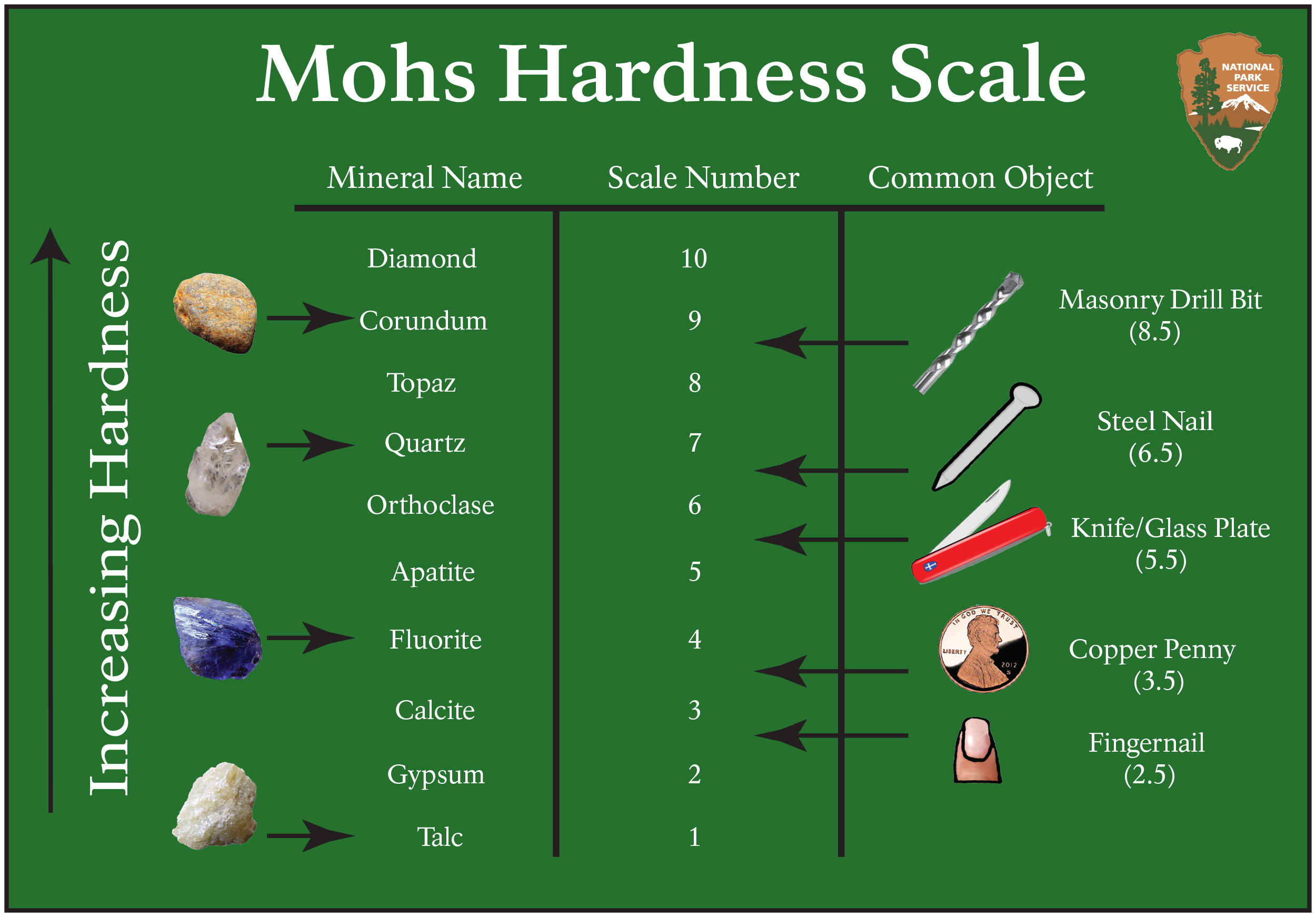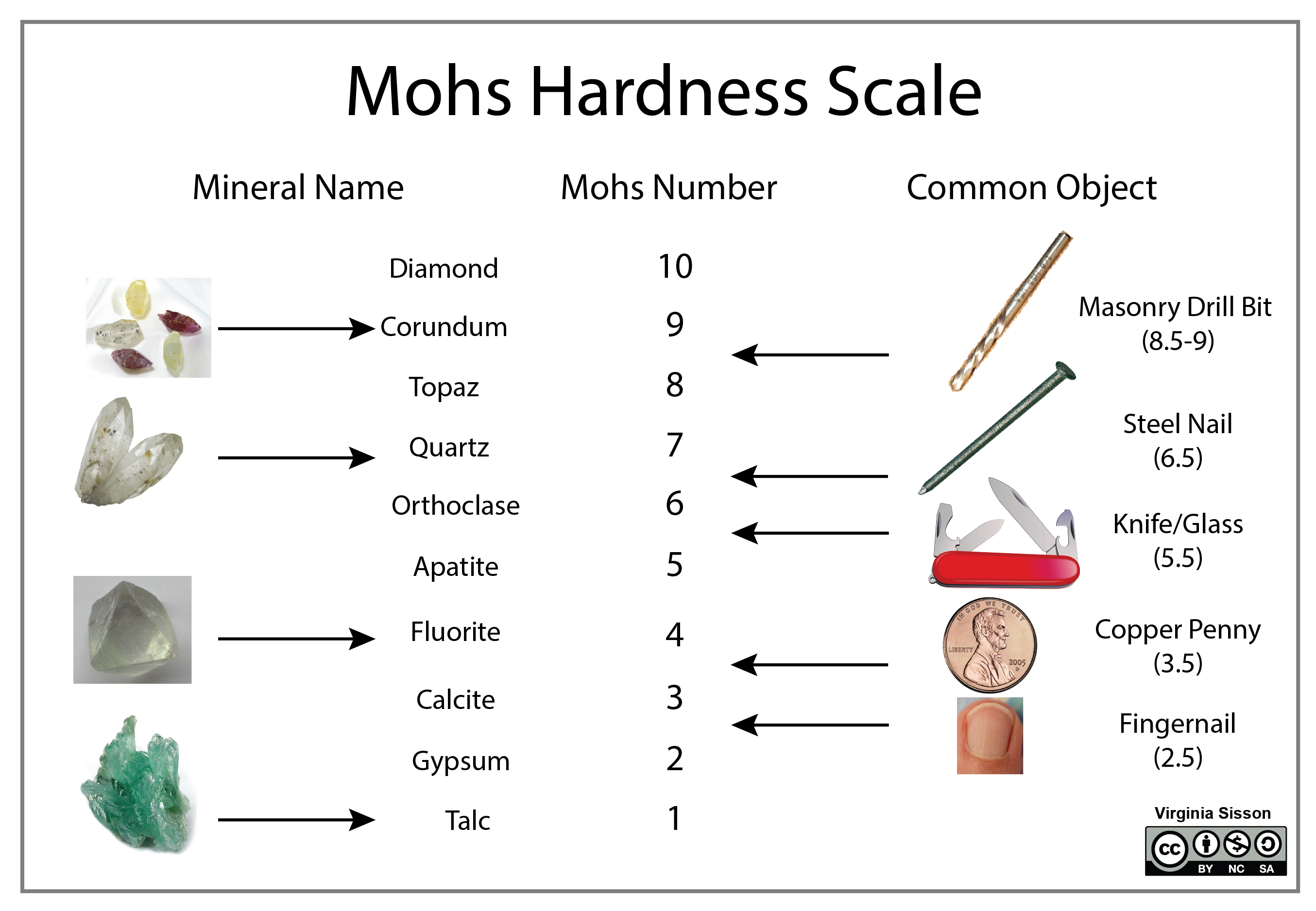Describe How to Find the Hardness of an Unknown Mineral
You know then that the minerals hardness is between 5 and 6. Select a fresh clean surface on the specimen to be tested.

Identification Of Minerals Ck 12 Foundation
A fingernail has a hardness of about 25.

. Diamond quartz and framework silicates such as feldspar. Your fingernail has a hardness of around 25. The hardness of minerals is diagnostic because the hardness is determined by the strength of bonds and the structure of the mineral lattice.
This graphic outlines the index minerals and some common objects that are used to determine a minerals hardness. Imagine you have an unknown mineral. Fjwzz5kvhr fjwzz5kvhr 07132021 Biology High School answered Describe how to find the hardness of an unknown mineral.
One of the most important tests for identifying mineral specimens is the Mohs Hardness Test. Hardness is a measure of a minerals resistance to abrasion. The unknown mineral is scratched with another object that the hardness is known.
A numerical value for hardness is determined using a scale that ranges from 1 softest to 10 hardest. Geologists use the Mohs Hardness scale and the items on the scale to determine the hardness of a mineral sample. You would use common objects or known minerals to find out what would scratch an unknown mineral.
Knoop Hardness HK Applied test force in kilogram-force kgf Surface area of indentation mm 2 or HK 14229 x FD 2 Mohs Hardness Test. The hardness of unknown minerals can be determined by using a method called the Scratch test. How to perform the test To test the hardness of a mineral try to scratch the surface of your unknown sample with a mineral or object from the hardness scale listed aboveIf the unknown sample can not be scratched by the known mineral or object the hardness of your sample is greater.
Each mineral will scratch all that precedeit and be scratched by all that follow it. Take an unknown mineral and scratch it with an object of known hardness like a fingernail or a mineral like quartz Through trial and observation you can determine your minerals hardness a key identification factor. This method is especially useful for identifying.
Find an answer to your question Describe how to find the hardness of an unknown mineral. A penny has a hardness of 30 - slightly harder than your fingernail. By using a simple scratch test you can determine the relative hardness of an unknown mineral.
Pennies have a hardness of three. The Mohs scale of mineral hardness is a qualitative ordinal scale from 1 to 10 characterizing scratch resistance of various minerals through the ability of harder material to scratch softer material. You can use the minerals in the scale to test the hardness of an unknown mineral.
Add your answer and earn points. You find that it can scratch fluorite or even apatite but feldspar scratches it. Quartz is a 7 so it can.
Minerals are tested for hardness by performing a scratch test. Gold only has a hardness of 25 - 3 -. For measuring the hardness of a mineral several common objects that can be used for scratching are helpful such as a fingernail a copper coin a steel pocketknife glass plate or window glass the steel of a needle and.
The Knoop hardness is calculated by the following formula. Hardeness test can be used comparing minerals of knownhardness against unknown minerals. Window glass has a hardness of 60 and a common knife blade is a 65.
By comparing unknown minerals to these common objects you can determine their hardness. Then you can compare that information to data tables which show the hardness of common minerals. In other words it is slightly harder than gypsum H2 but softer than calcite H3.
The minerals are arranged in order of increasing hardness. Even though the color of a mineral may vary its streak does not. 3 on a question Describe how to find the hardness of an unknown mineral.
HARDNESS The hardness of a mineral can be measured by its resistance to scratching or abrasion. Describe the soft end of Mohs hardness scale. There are different types of scales present and numbered which tells the.
Hold the specimen firmly and attempt to scratch it with the point of an object of known hardness. The degree of hardness is determined by observing the comparative ease or difficulty with which one mineral is scratched by another or by a steel tool. For example if your sample was not scratched by fluorite the hardness of your.
Developed by a German mineralogist Friedrich Mohs the Mohs Hardness Scale assigns hardness values to 10 representative minerals as well as other common materials penny knife blade etc. For example powdery talc has a Mohs hardness of 1. A mineral is rubbed up against a piece of unglazed tile called a streak plate.
Once a material scratches the mineral it can be compared on the Mohs hardness scale 2. So if you cant scratch the specimen with your fingernail H25 but a penny does the job you immediately. As you can see diamond is a 10 on Mohs Scale.
Hardness is a quantification of how easy it is for a compound or an object to be scratched or to be pierced. Describe how to find the hardness of unknown mineral. The Mohs scale is as follows.
Diamond is the hardest mineral which means that no other mineral can scratch a diamond. Note that no other mineral can scratch diamond. In this example we use a sharp quartz H7 crystal.
This test compares the resistance of a mineral to being scratched by ten reference minerals known as the Mohs Hardness Scale see table at left. Talc is the softest mineral - it has a rating of 1. The Knoop hardness test creates a rhombohedral indentation with one diagonal being seven times longer than the other.
With a Mohs scale anyone can test an unknown mineral for its hardness. The test is useful because most specimens of a given mineral are very close to the same hardness. A streak test can be performed.
The Mohs scale is a set of 10 common minerals chosen for comparative hardness. By using this method one can determine the hardness of an unknown mineral. Hardness is basically the stress required to create and grow extended lattice defects such as micro-fractures stress twins and dislocations.
1 See answer Advertisement Advertisement fjwzz5kvhr is waiting for your help. If you can scratch the surface of an unknown specimen with it you will immediately know that its hardness is less than 25. You could crumble it between your fingers.
A minerals hardness is a measure of its relative resistance to scratching measured by scratching the mineral against another substance of known hardness on the Mohs Hardness Scale. Mohs scale of mineral hardness. Learn how to use the scale when identifying.

Mohs Hardness Scale U S National Park Service

Chapter 2 Earth Materials The Story Of Earth An Observational Guide

0 Response to "Describe How to Find the Hardness of an Unknown Mineral"
Post a Comment